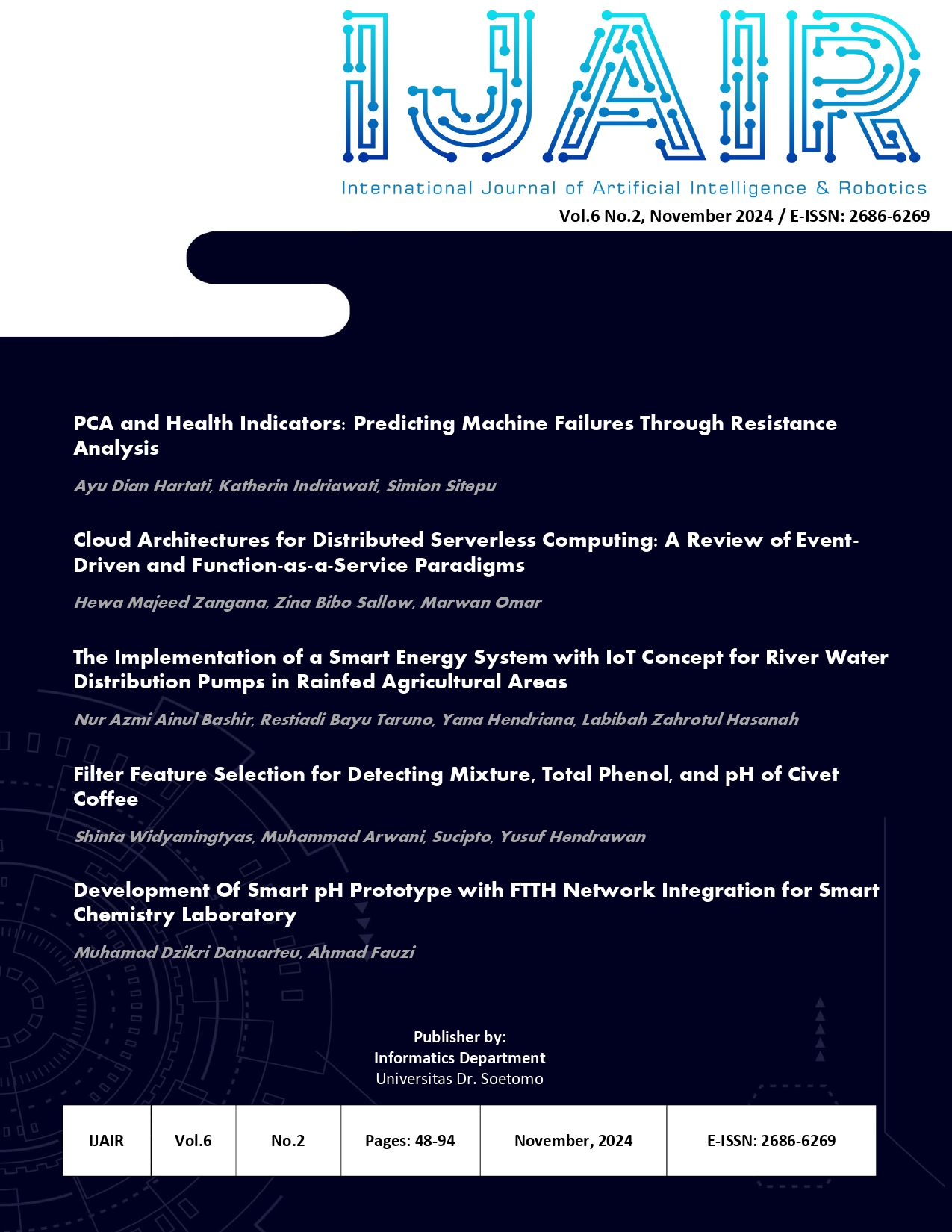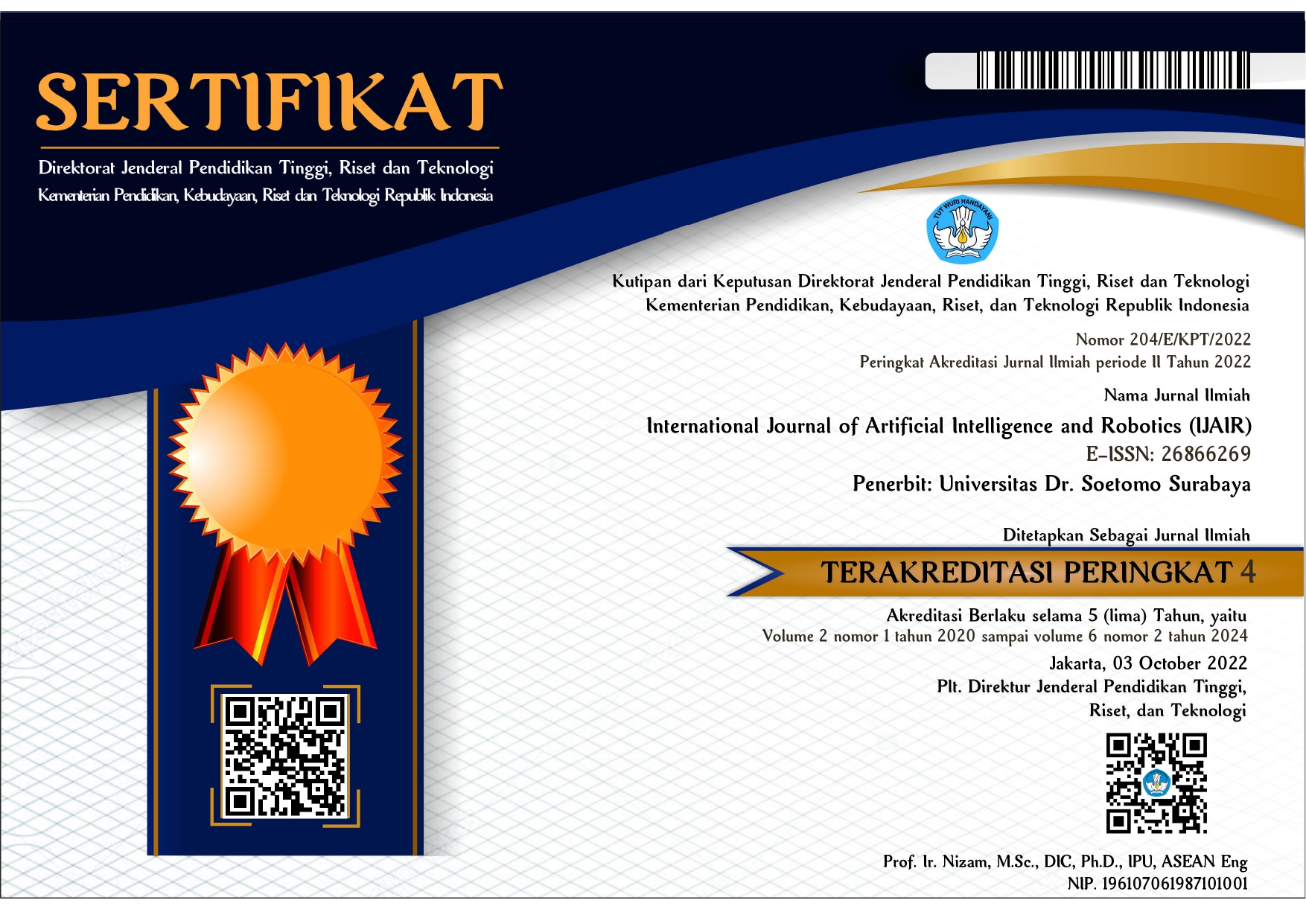Filter Feature Selection for Detecting Mixture, Total Phenol, and pH of Civet Coffee
 Abstract views: 163
,
Abstract views: 163
,
 PDF downloads: 110
PDF downloads: 110
Abstract
Civet coffee, a highly valued specialty coffee, is susceptible to adulteration with regular coffee, resulting in economic losses and consumer fraud. This study investigates the potential of electrical spectroscopy as a non-destructive technique for detecting civet coffee adulteration. We analyzed the bioelectrical properties of civet coffee beans and their mixtures with regular coffee, focusing on impedance parameters (Z, Lp, Ls, Rp, Rs) as potential indicators of adulteration. Two machine learning models, Artificial Neural Network (ANN) and Random Forest, were trained and evaluated using Mean Squared Error (MSE) validation to identify the most informative features for predicting mixture composition, total phenol content, and pH. The findings demonstrate that impedance parameters, particularly Z, consistently exhibited high feature importance scores across different attribute evaluators and search methods. The optimal model, an ANN with a correlation attribute evaluator and ranker search method, achieved an MSE validation of 0.0479, indicating strong predictive accuracy. These results suggest that electrical spectroscopy, coupled with machine learning, offers a promising approach for developing automated, non-invasive methods for detecting civet coffee adulteration, thereby protecting consumers and ensuring the integrity of the specialty coffee market.
Downloads
References
M. Muzaifa, D. Hasni, and F. Rahmi, "What is kopi luwak? A literature review on production, quality and problems," in IOP Conference Series: Earth and Environmental Science, 2019, vol. 365, no. 1, p. 12041.
A. Patria, A. Abubakar, and M. Muzaifa, "Physicochemical and sensory characteristics of luwak coffee from Bener Meriah, Aceh-Indonesia," in IOP Conference Series: Earth and Environmental Science, 2018, vol. 196, no. 1, p. 12010.
I. E. Panggabean, Buku pintar kopi. AgroMedia, 2011.
A. H. Ishak, S. Moidin, S. N. M. Rejab, and M. H. Mahaiyadin, "The Commercialisation of Halal and Tayyib Palm Civet Coffee," al-Qanatir Int. J. Islam. Stud., vol. 29, no. 1, pp. 46–56, 2023.
M. Yulia and D. Suhandy, "Indonesian palm civet coffee discrimination using UV-visible spectroscopy and several chemometrics methods," in journal of physics: conference series, 2017, vol. 835, no. 1, p. 12010.
U. Jumhawan, S. P. Putri, T. Bamba, and E. Fukusaki, "Quantification of coffee blends for authentication of Asian palm civet coffee (Kopi Luwak) via metabolomics: A proof of concept," J. Biosci. Bioeng., vol. 122, no. 1, pp. 79–84, 2016.
S. Widyaningtyas, S. Sucipto, and Y. Hendrawan, “DETEKSI PEMALSUAN KOPI LUWAK MENGGUNAKAN SIFAT BIOLISTRIK DAN JARINGAN SARAF TIRUAN,†J. Teknol. Pertan., vol. 19, no. 3, pp. 161–172, 2018.
M. Jeszka-Skowron, A. Zgoła-Grześkowiak, and T. Grześkowiak, "Phenolic compounds in coffee and tea beverages," Anal. methods Determ. Bioact. Compd. Elem. food, pp. 31–81, 2021.
S. O. Nelson and S. Trabelsi, "Factors Influencing the Dielectric Properties of Agricultural and Food Products," J. Microw. Power Electromagn. Energy, vol. 46, no. 2, pp. 93–107, 2012, doi: 10.1080/08327823.2012.11689828.
S. Sucipto, M. Anna, M. Arwani, and Y. Hendrawan, "A rapid classification of wheat flour protein content using artificial neural network model based on bioelectrical properties," TELKOMNIKA (Telecommunication Comput. Electron. Control., vol. 17, no. 2, pp. 920–927, 2019.
R. Sumranbumrung, A. Siritaratiwat, and A. Kruesubthaworn, "The simulation of sugar content estimation of sugarcane based on dielectric properties for microwave imaging technique," J. Eng. Innov., vol. 17, no. 3, pp. 35–42, 2024.
A. Purohit, A. Kumari, A. Roy, and A. Mohan, "Determination of dielectric properties and predictive modeling for designing radio-frequency heating of ground beef," Front. Food Sci. Technol., vol. 2, p. 960471, 2022.
C. Dong et al., "Rapid detection of catechins during black tea fermentation based on electrical properties and chemometrics," Food Biosci., vol. 40, p. 100855, 2021.
J. Sun, Y. Tian, X. Wu, C. Dai, and B. Lu, "Non-destructive detection for moisture content in green tea based on dielectric properties and VISSAâ€GWOâ€SVR algorithm," J. Food Process. Preserv., vol. 44, no. 5, p. e14421, 2020.
G. Ansari, T. Ahmad, and M. N. Doja, "Hybrid filter–wrapper feature selection method for sentiment classification," Arab. J. Sci. Eng., vol. 44, pp. 9191–9208, 2019.
X. Zhang, Q. Zhang, M. Chen, Y. Sun, X. Qin, and H. Li, "A two-stage feature selection and intelligent fault diagnosis method for rotating machinery using hybrid filter and wrapper method," Neurocomputing, vol. 275, pp. 2426–2439, 2018.
B. Pourmohammadali, M. H. Salehi, S. J. Hosseinifard, I. E. Boroujeni, and H. Shirani, "Studying the relationships between nutrients in pistachio leaves and its yield using hybrid GA-ANN model-based feature selection," Comput. Electron. Agric., vol. 172, p. 105352, 2020.
T. N. Pham, L. Van Tran, and S. V. T. Dao, "Early disease classification of mango leaves using feed-forward neural network and hybrid metaheuristic feature selection," IEEE access, vol. 8, pp. 189960–189973, 2020.
Y. Hendrawan, S. Widyaningtyas, and S. Sucipto, "Computer vision for purity, phenol, and pH detection of Luwak Coffee green bean," TELKOMNIKA (Telecommunication Comput. Electron. Control., vol. 17, no. 6, pp. 3073–3085, 2019.
Z. Zhao, L. Wang, H. Liu, and J. Ye, "On similarity preserving feature selection," IEEE Trans. Knowl. Data Eng., vol. 25, no. 3, pp. 619–632, 2011.
T. Dokeroglu, A. Deniz, and H. E. Kiziloz, "A comprehensive survey on recent metaheuristics for feature selection," Neurocomputing, vol. 494, pp. 269–296, 2022.
M. A. Hall, "Correlation-based feature subset selection for machine learning," Thesis Submitt. Partial fulfilment Requir. degree Dr. Philos. Univ. Waikato, 1988.
E. R. M. Saleh, E. Noor, T. Djatna, and I. TIP, “Seleksi Parameter Dielektrik Penentuan Masa Kadaluwarsa Biskuit (Wafer) dengan Pendekatan Regresi Linier, Feature Selection (Relieff) dan Artificial Neural Network,†J. Teknol. Ind. Pertan., vol. 23, no. 2, 2013.
H. Liang, G. Liu, H. Zhang, and T. Huang, "Neural-network-based event-triggered adaptive control of nonaffine non-linear multiagent systems with dynamic uncertainties," IEEE Trans. Neural Networks Learn. Syst., vol. 32, no. 5, pp. 2239–2250, 2020.
O. I. Abiodun et al., "Comprehensive review of artificial neural network applications to pattern recognition," IEEE access, vol. 7, pp. 158820–158846, 2019.
O. M. Adisa et al., "Application of artificial neural network for predicting maize production in South Africa," Sustainability, vol. 11, no. 4, p. 1145, 2019.
M. Islam, G. Chen, and S. Jin, "An overview of neural network," Am. J. Neural Networks Appl., vol. 5, no. 1, pp. 7–11, 2019.
U. A. Umoh, I. J. Eyoh, V. S. Murugesan, and E. E. Nyoho, "Fuzzy-machine learning models for the prediction of fire outbreaks: A comparative analysis," in Artificial Intelligence and Machine Learning for EDGE Computing, Elsevier, 2022, pp. 207–233.
P. Dutta, S. Paul, and A. Kumar, "Comparative analysis of various supervised machine learning techniques for diagnosis of COVID-19," in Electronic devices, circuits, and systems for biomedical applications, Elsevier, 2021, pp. 521–540.
M. Belgiu and L. Drăguţ, "Random forest in remote sensing: A review of applications and future directions," ISPRS J. Photogramm. Remote Sens., vol. 114, pp. 24–31, 2016.
Y. Liu, "Random forest algorithm in big data environment," Comput. Model. new Technol., vol. 18, no. 12A, pp. 147–151, 2014.
R. Zebari, A. Abdulazeez, D. Zeebaree, D. Zebari, and J. Saeed, "A comprehensive review of dimensionality reduction techniques for feature selection and feature extraction," J. Appl. Sci. Technol. Trends, vol. 1, no. 1, pp. 56–70, 2020.
V. Bolón-Canedo, N. Sánchez-Maroño, and A. Alonso-Betanzos, "Feature selection for high-dimensional data," Prog. Artif. Intell., vol. 5, pp. 65–75, 2016.
S. Khalid, T. Khalil, and S. Nasreen, "A survey of feature selection and feature extraction techniques in machine learning," in 2014 science and information conference, 2014, pp. 372–378.
H. Ramaswamy and J. Tang, "Microwave and radio frequency heating," Food Sci. Technol. Int., vol. 14, no. 5, pp. 423–427, 2008.
S. Ryynänen, "The electromagnetic properties of food materials: a review of the basic principles," J. Food Eng., vol. 26, no. 4, pp. 409–429, 1995.
H. Suprajitno, "Experimental Analysis of Training Parameters Combination of ANN Backpropagation for Climate Classification.," Math. Model. Eng. Probl., vol. 9, no. 4, 2022.
M. Uzair and N. Jamil, "Effects of hidden layers on the efficiency of neural networks," in 2020 IEEE 23rd international multitopic conference (INMIC), 2020, pp. 1–6.
S. Sucipto et al., "Prediction of water content, sucrose and invert sugar of sugarcane using bioelectrical properties and artificial neural network," Int. Food Res. J., vol. 25, no. 6, pp. 2674–2680, 2018.
G. T. Kumar and R. Khalid, "Optimizing Deep Neural Network Architecture: A Tabu Search Based Approach," Comput. Sci. springer, 2018.
S. Asthana, A. Pandit, and A. Bahrdwaj, "Analysis of multiple hidden layers vs. accuracy in performance using back propagation neural network," Indian J. Sci. Technol., vol. 10, no. 4, pp. 1–4, 2017.
M. R. S. Mohd, J. Johari, F. A. Ruslan, N. A. Razak, S. Ahmad, and A. S. M. Shah, "Analysis of Training Function for NNARX in Solar Radiation Prediction Modeling," in Proceedings of the 8th International Conference on Computational Science and Technology: ICCST 2021, Labuan, Malaysia, 28–29 August, 2022, pp. 619–632.
K. Mehranzamir, Z. Abdul-Malek, H. N. Afrouzi, S. V. Mashak, C. Wooi, and R. Zarei, "Artificial neural network application in an implemented lightning locating system," J. Atmos. Solar-Terrestrial Phys., vol. 210, p. 105437, 2020.
Y. Liu, H. Chen, L. Zhang, and Z. Feng, "Enhancing building energy efficiency using a random forest model: A hybrid prediction approach," Energy Reports, vol. 7, pp. 5003–5012, 2021.
Copyright (c) 2024 Shinta Widyaningtyas, Muhammad Arwani, Sucipto Sucipto, Yusuf Hendrawan

This work is licensed under a Creative Commons Attribution-ShareAlike 4.0 International License.
Authors who publish with International Journal of Artificial Intelligence & Robotics (IJAIR) agree to the following terms:
-
Authors retain copyright and grant the journal right of first publication with the work simultaneously licensed under a Creative Commons Attribution License (CC BY-SA 4.0) that allows others to share the work with an acknowledgment of the work's authorship and initial publication in this journal.
-
Authors are able to enter into separate, additional contractual arrangements for the non-exclusive distribution of the journal's published version of the work (e.g., post it to an institutional repository or publish it in a book), with an acknowledgment of its initial publication in this journal.
-
Authors are permitted and encouraged to post their work online (e.g., in institutional repositories or on their website) prior to and during the submission process, as it can lead to productive exchanges, as well as earlier and greater citation of published work.















